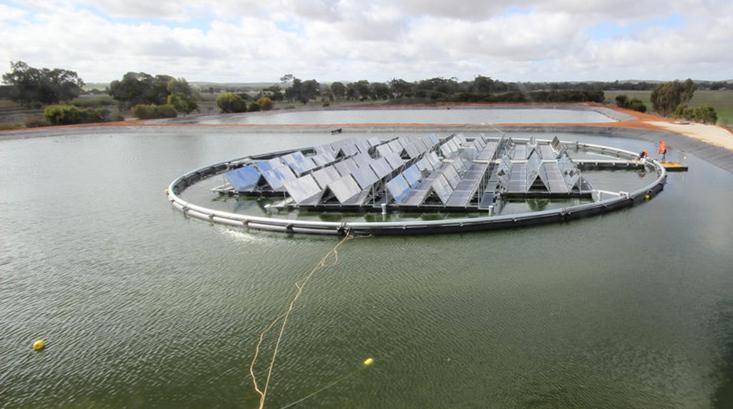As the camera drone glides over solar panels floating on the waters of the Higashihira and Nishihira reservoirs in Kato City, west of Osaka, it slowly reveals one of Japan's most innovative solar power projects.
Kyocera Corp, a pioneer in photovoltaics, chose a water-based site because Japan's crowded countryside has become a development bottleneck. Once the quick seven-month installation was complete, the 11,250 modules began generating the first of 3,300 megawatt hours (MWh) a year supplying electricity to a thousand households.
The modules were installed on patented Hydrelio floating platforms manufactured by the French company Ciel et Terre. "In every country, there are large bodies of water for mining, irrigation, aquaculture, chemical plant treatment or wastewater treatment,” Eva Pauly, business manager for Ciel et Terre, told Greentech Media. “When you build solar plants on water, you do not [have a] conflict with the usage of the land.”
Ciel et Terre opened a factory in Japan to cut costs. Also, Post Fukushima, where constructing earthquake-proof foundations can be prohibitively expensive, floating solar is more competitive than ground-mounted systems because the panels are placed right on top of the floating structure during a quick installation.
Water's multiple benefits
According to Kyocera, cooling from the water in the reservoir makes the panels 11% more efficient, while they shield the water from the sun and significantly reduce evaporation. This system has been designed specifically for lakes and reservoirs that are close to the grid. Although it's not built for rough, offshore conditions, it can withstand typhoons with waves 3 feet high.
For a brief moment this was the world's largest floating solar power plant, until Kyocera announced plans to break its own record with the construction of a 13.4MW solar power plant on the Yamakura Dam reservoir in Chiba Prefecture. Power from 50,000 Kyocera solar modules will spread over 180,000 square meters of water and will be sold to Tokyo Electric Power Company (TEPCO).
Osaka's floating solar plant is part of a national trend. Japan has added over 11,090 megawatts of clean energy since July 2012, when it began a post-Fukushima incentive program to boost investment in renewables. The lavish feed-in tariffs have made the country one of the world's four largest markets for solar panels.
So as Japan retires nearly 2.4 gigawatts of expensive oil-fired energy plants by March next year, it's switching to alternative fuels, and as 43 nuclear reactors remain closed since the 2011 Fukushima disaster, renewable energy has tripled to 25 gigawatts, with solar making up more than 80 percent of that growth. The momenteum is building so fast that Japan has approved 71,780 MW of renewable energy projects, with solar accounting for 96 percent.
Powering an Australian waste water plant

Supplying power to a local waste water facility, phase one of Australia’s first floating solar plant was launched recently in Jamestown, South Australia.
The Sydney-based project developer, Infratech Industries, developed the $9.5 million 4MW PV system, which floats on top of the sewage water. At full size, the complete project will cover five basins of water and will supply enough energy to power the wastewater facility. Infratech's proprietary tracking, cooling, and concentrating technology also uses water to counteract energy loss from overheating.
Infratech’s chief executive Raj Nellore told Cleantechnica that the plant will run under a 25-year power purchase agreement with the owners, who will save about 15% on their energy costs. Any excess power will be sold to the community.
Avoiding expensive California vineyards
Obviously the US is much larger than Japan, and although the US installed over 6 GW of PV during 2014, there are still many areas closed-off to solar development, either because of high land prices or competition from agriculture.
In California, where Sonoma's successful vineyards have priced solar out of the local real estate market, county officials had to rethink project sites, and opted for uncovered waste water ponds. Once completed in 2016, the array - floating on treated sewage - will provide enough electricity to power 3,000 homes and will be the largest floating solar project in the US.
"Developing the project was very pragmatic," Cordel Stillman, an engineer at the Water Agency, told Cleantechnica, “We took a look and said ‘Where else can we put solar?’". The floating panels have another community benefit: the ponds will be leased from the Sonoma County Water Agency for $30,000 a year. The CEO of developer Pristine Sun, Troy Helming, said: “The owners will enjoy modest revenue by leasing the water surface rights in order for us to sell clean energy to the local utilities.”
Will water conservation and improved output trump traditional solar?
Images: Japan, Ciel et Terre; Australia, Infratech


